
New article published in APL !
We are thrilled to annouced that our work on electron trapping/detrapping in HZO has just been published in APL as featured/editor’s choice. This article dealt with expriments performed by W. Hamouda during his PhD work in the LENSIS. This project received funding from the European Union's Horizon 2020 research and innovation program under Grant Agreement No. 780302 3 FERRO.
Read more : https://doi.org/10.1063/5.0288835

New PhD student in the lab !
We are happy to welcome Jayshree Dadheech, our new PhD student in LENSIS.
I am Jayshree Dadheech from India. I have completed my Masters in Physics from the National Institute of Technology, Rourkela, India. I have a strong passion for exploring new aspects of nature which has led me to CEA and France. I am beginning my Ph.D. thesis at LENSIS, SPEC, CEA on “Advanced characterization of ferroelectric domains in hafnia-based thin films.” The aim of this project is to explore various properties of hafnium oxide-based thin films in real time for potential applications in ferroelectric random-access memories (FeRAMs). It will effectively utilize techniques like PFM, LEEM, PEEM and XPS to characterize and study the ferroelectric response in real time during the ferroelectric switching. I am looking forward to learn, connect and collaborate with colleagues here at CEA.
PhD funded by FerroFutures (https://www.pepr-electronique.fr/fer/).

New article published in Journal of Applied Physics !
We are thrilled to announce that our work has been recently published in Journal of Applied Physics. The article is entitled “Correct quantification of oxygen vacancies in ferroelectric hafnia”.
This work is a fruitful collaboration between the LENSIS, STMicroelectronics, the NaMLab, the Munich University of Applied Sciences, the Air Force Research Laboratory Materials and Manufacturing Directorate and the National Institute of Standards and Technology. This project was funded by the ANR project “D3PO” as well as the AFOSR project “GO-FERRO”
Read more here: https://doi.org/10.1063/5.0288354

Micro-XRD at Diffab on industrial MFIS stack !
Tom Iung, Thomas Cornélius (IM2NP), Lucía Pérez Ramírez, and Eun-Jin Koh recently conducted micro-X-ray diffraction (μ-XRD) experiments at the DIFFABS beamline of the SOLEIL synchrotron (Saint Aubin, France).
The main goal of this beamtime was to monitor in situ the crystallization (see picture) and phase evolution of a metal-ferroelectric (Si:HfO2)-insulator-semiconductor stack, which was fabricated in an industrial cleanroom at STMicroelectronics, Crolles. The annealing process, carried out between 450°C and 1000°C, aimed to assess the stack’s compatibility with both BeOL and FeOL processes. Additionally, the team evaluated potential phase transformations due to electric cycling for patterned stacks annealed at 750°C and 1000°C under industrial FeOL conditions.
This research is funded by the ANRT and the Ferro4EdgeAI (Grant agreement n° 101135656) project. The team expresses their gratitude to the Diffabs beamline scientist Cristian Mocuta for his support.

SSDM 2025
More than 1100 scientists took part in the 2025 edition of International Conference on Solid State Devices and Materials (https://ssdm.jp/) in Yokohama, Japan from 15th-18th September. Nearly 300 oral and 177 poster presentations covered a wide range of subjects from Flash memory, through design, photonics to wide band semiconductors and, of course, ferroelectrics for logic and memory technology. The latter attracted a record participation, with not less than 5 sessions dedicated to ferroelectrics.
Conference highlights included the plenary talk by Myeong-Jae Park (SK Hynix) on the pressing need for high bandwidth memory, not only for learning but also for mass parallel processing. Jun Okuno (Sony corporation) presented an overview of recent work on ferroelectric memories including FeRAMs, NV SRAMS and MFM invertors. Zhenhong Liu (Tokyo University) and Fei Yu (Xidian university) both emphasized the key role of charge trapping at oxygen vacancies in determining imprint and degradation. Takuya Maeda’s presentation on Recent Advances in ferroelectric ScAIN/GaN-based High Electron Mobility Transistors also attracted much interest.
Ferro4EdgeAI was well represented by S. Martin, L. Grenouillet, L. Perez Ramirez and N. Barrett with three presentations, two posters from CEA/Iramis on Cycling voltage dependence of the oxygen vacancy concentration profile in 6 nm HfxZr1-xO2 based ferroelectric capacitors and Oxygen vacancy mobility and charge de-trapping in ultra-thin HZO-based ferroelectric capacitors as a function of annealing temperature, one oral by S. Martin (CEA/Leti) on 22nm FDSOI 7 nm Hf0.5Zr0.5O2 FeRAM Demonstration for Embedded Applications: from Ferroelectric Capacitors to FeRAM Arrays.

MAXPEEM beamtime !
On their quest to elucidate the influence of the top electrode material on the oxygen vacancy distribution of ultrathin HfZrO2 FeCAPs, the LENSIS recently completed a beamtime campaign at MAXPEEM. The beamline, located at Max IV synchrotron (Lund, Sweden) is specialized Spectroscopic PhotoElectron and Low Energy Electron Microscope (SPELEEM).
Lucía Pérez Ramírez and Nicholas Barrett characterized several capacitors with different electrode materials (W or TiN), cycling (pristine, woken up, fatigued), and polarization states (up or down), to analyse the effect of material parameters on the vacancy distribution.
These results should complement the ones obtained during the Diffabs campaign (SOLEIL, https://www.ferro4edgeai.eu/news/micro-xrd-at-diffabs/soleil-fecap-phase-composition ) and contribute to building a comprehensive picture of the material characterization of HZO micro-structured FeCAPs.
This work supported by the ANR-DFG D3PO and Ferro4EdgeAI projects (https://www.ferro4edgeai.eu/). The team gratefully acknowledges the expert support of the beamline team: Evangelos Golias, Yuran Niu, and Weihua Lin.

Collaboration CEA Leti – FMC
Two Ferro4EdgeAI partners have announced a close collaboration to develop FMC’s Cache+ chiplet, a low power high density alternative to standard SRAMs using 1T-1C FeRAMs with HfZrO2.
CACHE+ reimagines SRAM, the high-speed CACHE used throughout computing. It delivers ten times the density of conventional SRAM while reducing standby power by a factor of ten. It also adds persistence, and is designed to integrate seamlessly with next-generation chiplet architectures for ultra-high-performance AI inference systems. Together, these capabilities unlock new possibilities for system designers who are rethinking architectures from the ground up. Crucial for AI data centers which cannot continue consuming power at their current trajectory.
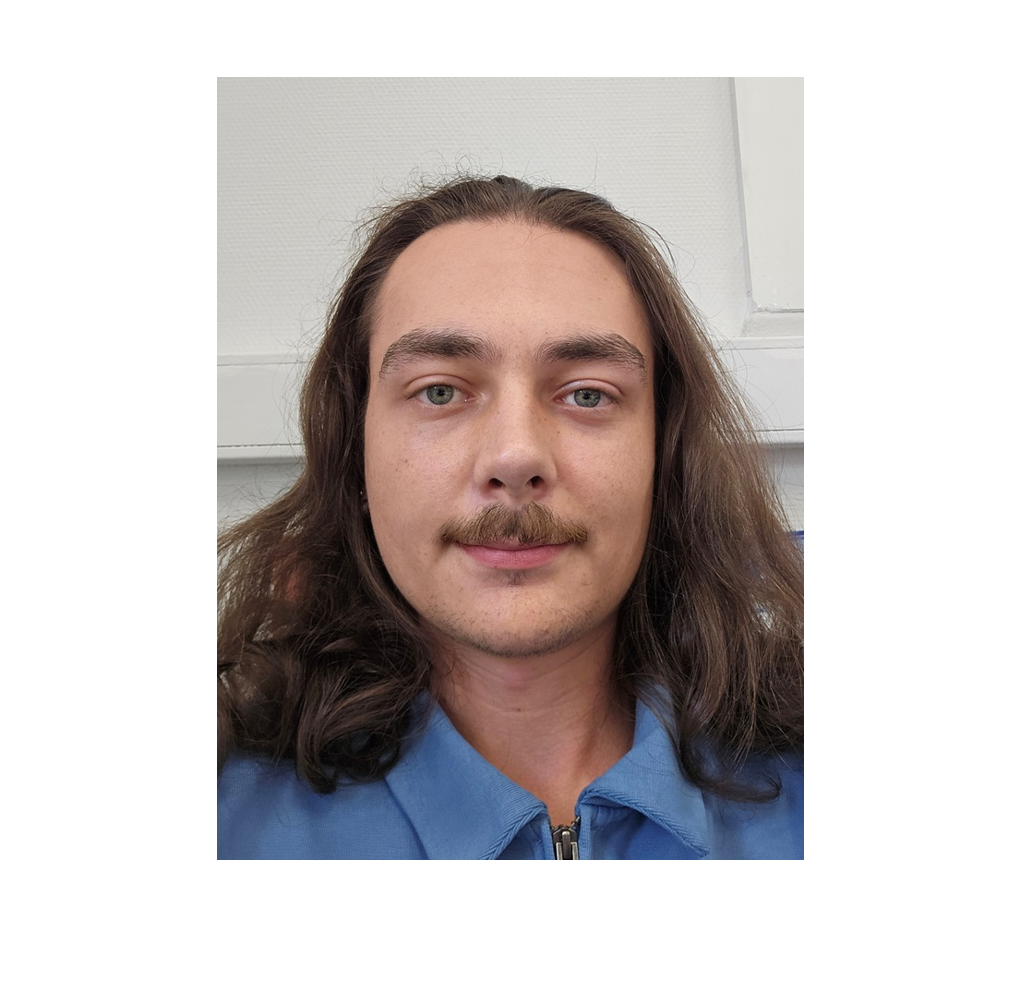
New PhD student !
Welcome to Antoine Arnould, who has just begun a PhD thesis at LENSIS on the physics of AlBN/Ga₂O₃ and AlBN/GaN interfaces for power electronics in collaboration with AFRL (Dayton, OH, USA). He obtained his bachelor's and master's degrees in condensed matter physics at the University of Lorraine, Nancy.
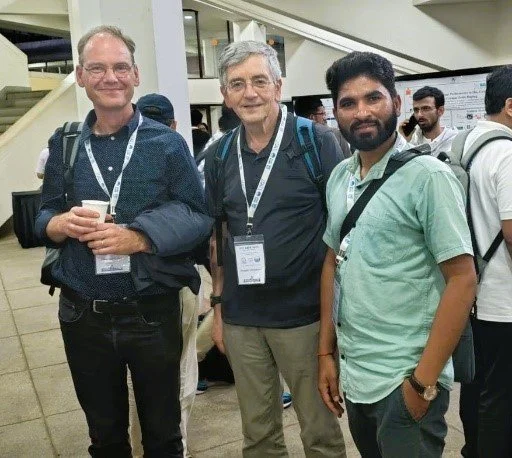
Insights from SAFS 2025 !
Dr. Somnath Kale, a postdoctoral researcher from LENSIS, recently attended and presented at the IEEE South Asian Ferroelectric Symposium (SAFS 2025) held in Bengaluru, India. As the first edition of the conference, it marked an important milestone for the regional research community in ferroelectrics. Somnath presented a poster titled “Investigating Polarization Switching and Retention in Hf₀.₆Zr₀.₄O₂ Thin Films Using Piezoresponse Force and Photoemission Electron Microscopy.” During the event, he engaged in valuable discussions with our project partners, including Dr. Uwe Schroeder from NamLab and Dr. Jordan Bouaziz from EC Lyon. Prof. Andrei Kholkin showed strong interest in the PFM results, while Dr. Sujit Das from the Indian Institute of Science (IISc) was particularly enthusiastic about the PEEM-based findings.
This research is supported by the European Union’s Horizon Europe research and innovation programme under Grant Agreement No. 101135656 (Ferro4EdgeAI).

The LENSIS lab at ISOE 2025 !
Two members of our lab, Somnath-Dadabhau Kale and Eun Jin Koh, shared their latest work on “Investigating polarization switching and retention in Hf0.6Zr0.4O2 thin films using piezoresponse force and photoemission electron microscopy,” and Eun Jin Koh presented her work “Stoichiometry analysis of atomic layer deposition of ferroelectric Hf1-xZrxO2” at the International School of Oxide Electronics (CNRS) in Cargèse, France.
🔗 Read more: https://lnkd.in/eN6zA8QF
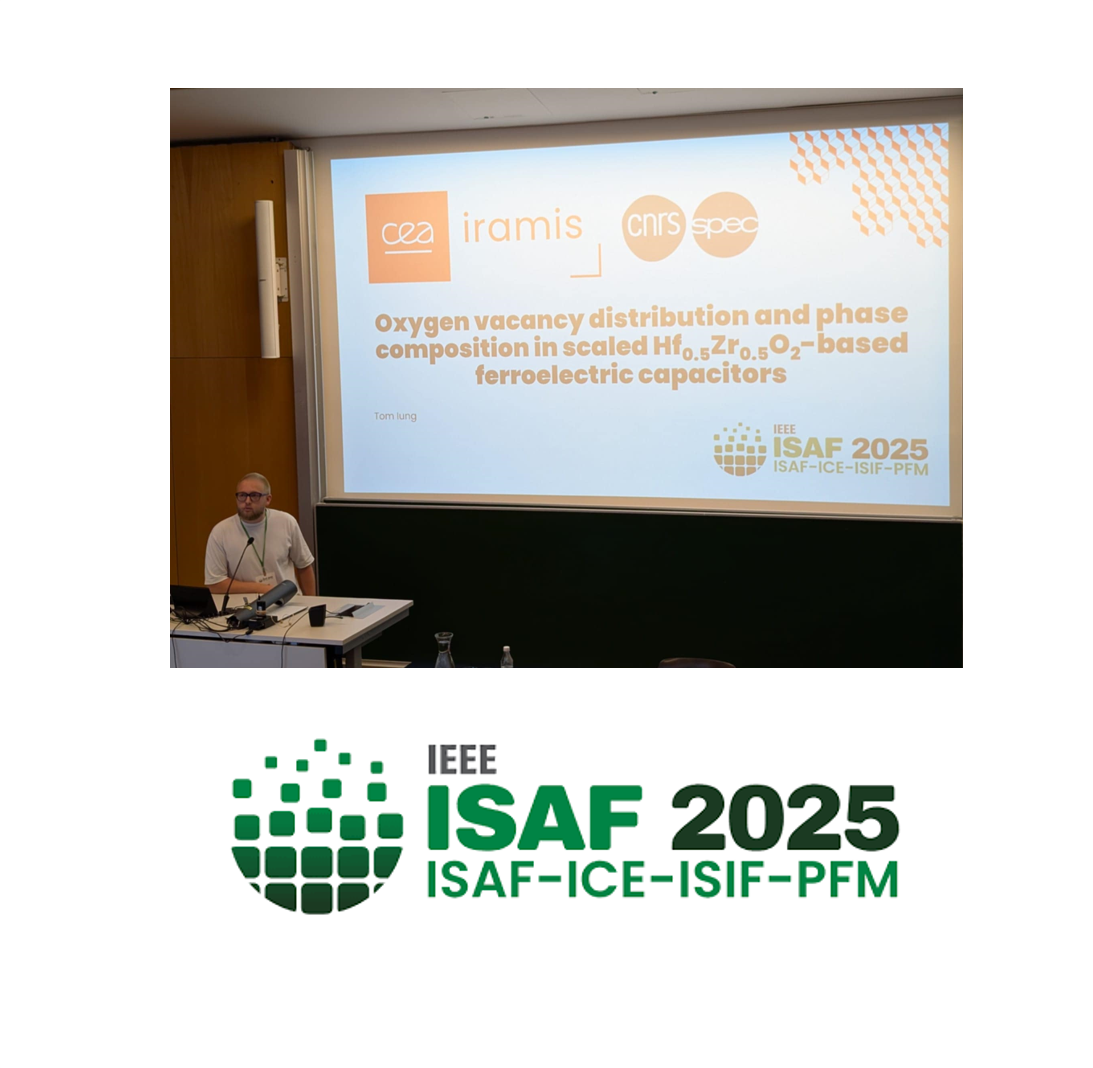
The LENSIS lab at ISAF 2025 !
At the International Symposium on Applications of Ferroelectrics (ISAF 2025) in Graz, Austria, our laboratory was represented by PhD student Tom Iung, who delivered an oral presentation titled "Oxygen Vacancy Distribution and Phase Composition in Scaled Hf₀.₅Zr₀.₅O₂-Based Ferroelectric Capacitors." We want to acknowledge the ANR-DFG D3PO and Ferro4EdgeAI projects (https://www.ferro4edgeai.eu/) for the support as well as STMicroelectronics.
ISAF 2025 featured a strong lineup of talks on hafnia-based ferroelectrics. Strain and stress emerged as particularly trendy topics, highlighted by discussions on stoichiometry changes and their impact on material properties.

Micro-XRD at Diffabs/Soleil FeCAP phase composition
Adityanarayan Pandey, Lucía Pérez Ramírez, Eun Jin Koh, and Nicolas Vaxelaire (CEA Leti) recently completed micro-X-ray diffraction (μ-XRD) experiments on the DIFFABS beamline at the SOLEIL synchrotron (Saint Aubin, France).
The objective of this session was to investigate the structural phase transformations and strain evolution in hafnium-zirconium oxide (HfₓZr₁₋ₓO₂, or HZO) ferroelectric capacitors (FeCAPs), with cycling conditions. TiN/HZO/TiN capacitors, where the total HZO layer thicknesses were 5, 7, and 9 nm and the compositional variants of the Hf:Zr ratio (1:2, 1:1, and 2:1) were studied. The HZO thin films were supplied by Uwe Schroeder’s team at NaMLab gGmbH (Dresden, Germany) while the single FeCAPs were fabricated at CEA Saclay at the SPEC nanofab facility.
This work supported by the ANR-DFG D3PO and Ferro4EdgeAI projects (https://www.ferro4edgeai.eu/ ). The team gratefully acknowledges the expert support of beamline scientist Cristian Mocuta.

New article published in scientific reports !
We are happy to announce that our work has been recently published in scientific reports. The article is entitled “Bias dependent band alignment in Ga2O3 ferroelectric interface by operando HAXPES”. This the key result of the GO-FERRO project, funded by the AFOSR (the Air Force Office of Scientfic Research), collaboration with the team of Tyson Back AFRL (Air Force Research Laboratory), experiments done on the Galaxies beamline at Soleil synchrotron.
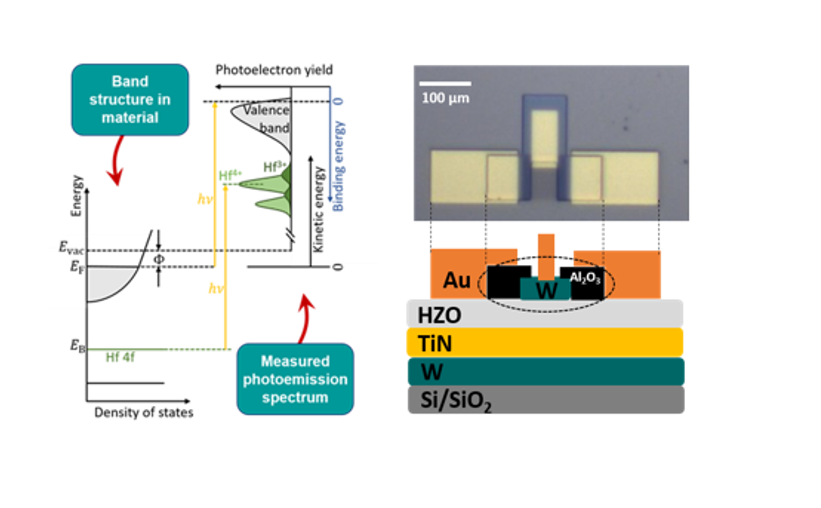
New article published in APL !
We are happy to announce that our work has been recently published in Applied Physics Letters. The article is entitled “Oxygen vacancy distribution and phase composition in scaled, Hf0.5Zr0.5O2-based ferroelectric capacitors”.

New PhD position !
A new PhD position is open in our laboraory. Its title is : “Advanced characterization of ferroelectric domains in hafnia-based thin films”, funded by the PEPR Ferrofutures (https://www.pepr-electronique.fr/fer/) and the Horizon EuropeFerro4edgeAI project (https://www.ferro4edgeai.eu/).
Don’t hesitate to dive deeper into the subject in our “Open positions” section.
If you’re interested, you can contact:
nick.barrett@cea.fr/lucia.perezramirez@cea.fr

HREELM - High resolution electron energy loss microscopy – 4
We are delighted to announce that the HREELM project is one of this year’s laureats of the SESAME 2024 call, supported by the Ile-de-France region
The aim
Imaging for the first time the surface vibrational states with nanometric spatial resolution
This will be done by full filed imaging of loss energy electron energy losses in real and reciprocal space at high spatial (15 nm) spectral (5 meV) and wave-vector (40 cm-1) resolutions.
More information can be found in the project section !

Santiago’s PhD defense !
Santiago defended his PhD and answered brillantly the jury members questions (from left to right : Jérôme Wolfman, Eugénie Martinez, Maria Christine Richter, Mathieu Frégneaux, Nick Barrett and Bruno Domenichini)
Once again, congratulations !

Kale Somnath Dadabhau arrival
Dr. Kale Somnath Dadabhau completed his PhD at the Indian Institute of Science Education and Research (IISER), Berhampur, India, where his research focused on investigating the effects of size and boundary conditions in ferroelectric thin films and tunnel junctions. Before his doctoral studies, he earned a Master’s degree in Physics from the Department of Physics, Savitribai Phule Pune University, India. Dr. Kale previously worked as a postdoctoral researcher at IISER Berhampur, where he focused on multiferroic tunnel junctions for next-generation non-volatile memories. His research interests include Material science, nanoelectronics, and the application of thin films in memory devices and energy-efficient technologies. He has received several awards, including the IEEE and SERB Travel Awards, as well as the Sanjay Shewale Prize for academic excellence.
He has recently joined LENSIS as a postdoctoral researcher to work on the project Ferro4EdgeAI, “Scalable Ferroelectric-Based Accelerators for Energy Efficient Edge AI.” This project focuses on developing ultra-low-power, scalable edge accelerators for artificial intelligence, incorporating a memory-augmented neural network based on low-cost, high-density, multi-level, Back End of Line (BEoL) integrated ferroelectric (FE) technology. The project is conducted in collaboration with Horizon Europe CL4, Leti, NaMLab, INL, TU Delft, STMicroelectronics, FMC, and SynSense.

NVMTS conference !
“During my poster presentation on "Polarization Dependent Oxygen Vacancy Distribution in Ferroelectric Hf₀.₅Zr₀.₅O₂ Capacitors," I engaged in meaningful discussions with notable experts in the field, including Prof. Hwang, Prof. Jeon and Dr. Mueller. Key questions arose during these interactions: Prof. Datta inquired about the mechanisms behind oxygen vacancy migration under varying polarization conditions, which led me to explain the influence of built-in electric fields. I gained valuable insights into several fundamental physics concepts. I learned about the dynamics of oxygen vacancies, revealing how their migration affects device reliability and functionality. I explored energy barriers associated with vacancy movement and the significant role of built-in electric fields in shaping vacancy distribution. This understanding highlighted the challenges related to wake-up and fatigue effects in ferroelectric devices. Additionally, discussions on optimizing HZO materials reinforced the importance of precise fabrication techniques and their implications for next-generation memory technologies.” (Dr. Gunjan Yadav)
We want to acknowledge the PEPR Diadem MicroElec project for the funding.

Spring-8 beamtime !
Successful HAXPES beamtime for Gunjan Yadav’s project on the BL09XU beamline of the Spring-8 synchrotron in Japan. Many thanks to Akira Yasui, Seo Okkyun, Jiagi Tang and Ibrahima Gueye for their help and support! Hopefully we have some nice results on the oxygen vacancy depth profiles in 6 nm HZO capacitors made in CEA/LETI and cycled at different voltages.
Work supported by the MicroElec project of the PEPR Diadem and by the Horizon Europe Ferro4EdgeAI.
Here Gunjan, Ibrahima and Seo in front of the wide angle HAXPES analyzer.

EunJin Koh arrival
Eunjin Koh just recently joined the LENSIS. She studied physics for bachelor and material engineering for master, in Sungkyunkwan University in Suwon, South Korea. She is going to investigate hafnium based thin films using XPS.
Her thesis is funded by the Horizon Europe project Ferro4EdgeAI (https://www.ferro4edgeai.eu/)

Luis Azevedo Antunes arrival
Luis Azevedo Antunes earned his bachelor’s degree in Physical Engineering and a master’s degree in Micro- and Nanotechnology from the Munich University of Applied Sciences. During his master’s program, he spent a semester abroad at Clemson University in the USA. He received the Georg-Simon-Ohm Award for his master’s thesis titled “The Effects of Oxygen Defects on the Formation of the Ferroelectric Phase in Doped HfO2, Based on Density Functional Calculations.”, providing the motivation to pursue a Ph.D. in the same field. He is part of the team which secured second place at the Merck Innovation Cup for their work on neuro-inspired AI inference acceleration.
Luis has recently joined LENSIS as an external collaborator from the Munich University of Applied Sciences, a project partner of the D3PO initiative, “Dopant and Defect Physics for Device Optimization in Hafnium Oxide-based Devices.” This bilateral ANR-DFG project is in collaboration with CEA/LETI (Grenoble) and NaMLab (Dresden).

New artcile published on APL !
We are happy to announce that our work have been recently published on Applied Physics Letters. This article is entitled “Oxygen vacancy engineering in Si-doped, HfO2 ferroelectric capacitors using Ti oxygen scavenging layers”.
https://doi.org/10.1063/5.0205142

EDTM Conference
As part of our new partnership with Taiwan's National Yang Ming Chiao Tung University, Dr Sourav De presented a "Perspective Roadmap of Advanced HfO2-based Ferroelectric Field Effect Transistors" at the 8th Electron Devices Technology & Manufacturing Conference (EDTM) in Bangalore, India. You can find all the details on the publication section or directly here: https://doi.org/10.1109/EDTM58488.2024.10511366

New article published on PRL !
We are happy to announce that our work have been recently published on Physical Review Letters. This article is entitled “Ferroelastic Twin Angles at the Surface of CaTiO3 Quantified by Photoemission Electron Microscopy”. This article deals with Gregoire Magagnin PhD’s work in the team.

DIADEM WEBSITE
The new PEPR DIADEM website has just been released. In our team, this concerns Gunjan Yadav's postdoctoral work on the Microelec project: High throughput heterostructures elaboration and characterization for microelectronic applications.
Check out the different information here : https://www.pepr-diadem.fr/le-pepr-diadem/

Adityanarayan Pandey arrival
Dr Adityanarayan Pandey has done graduation and post-graduation from Mumbai University in Physics. He completed PhD in Physics from RRCAT, Indore (University: Homi Bhabha National Institute, BARC, Mumbai) in 2018. For the doctoral thesis, he worked on electrical and magnetic properties of magnetic ion-doped relaxor ferroelectrics. Then, he joined IIT Bombay as postdoctoral fellow from 2019-2023 in Metallurgical Engineering and Materials Science and Electrical Engineering Department. He was working on piezoelectric and magnetoelectric 2-2 bilayer/trilayer thin films for actuator applications and HfO2 based nanoscale ferroelectrics and PCMO-based resistive memory for Neuromorphic applications
He has just joined LENSIS as a postdoctoral researcher to work on the project D3PO “Dopant and Defect Physics for Device Optimization for Hafnium Oxide based Devices”, a bilateral ANR-DFG project in collaboration with CEA/LETI (Grenoble) NaMLab (Dresden), Munich University Applied Sciences.

Electron gun for the HREELM Project !
We are pleased to announce that Kimball Physics have finished the new electron gun which will be integrated into the HREELM prototype (https://anr.fr/Project-ANR-14-CE35-0019, we can also find details about the HREELM project in the Projects section). This tour de force of ultra-high vacuum, electron optics engineering should allow the production of highly monochromatic electrons for imaging surface vibrational states (collaboration with Daniel Comparat Laboratoire Aimé Cotton and Lionel Amiaud ISMO). The electron gun was realized thanks to a Labex NanoSaclay & PALM innovation project and internal funding from the CEA.
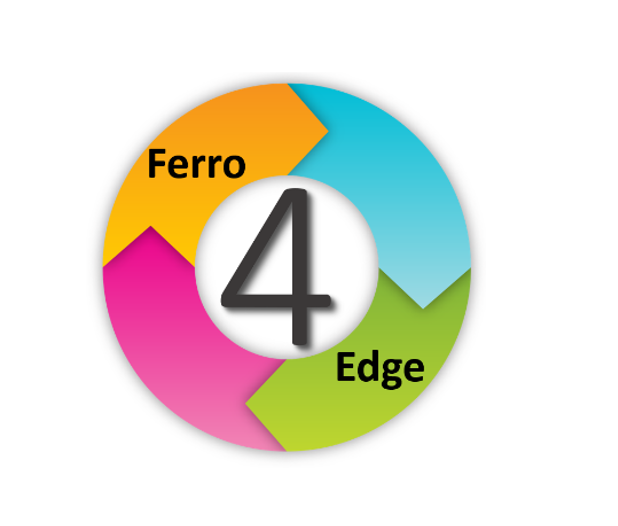
New open positions !
Two new positions have just been opened at LENSIS as part of the Ferro4edge project (1 postdoc and 1 PhD). Check out the "open positions" section, if you're interested !

Kick-Off du projet MicroElec
On November 30th, the MicroElec project was launched in front of ANR members. The aim of this project is a high throughput heterostructures elaboration and characterization for microelectronic applications. In our laboratory, we will perform HAXPES & PEEM analysis of multiple FeCAPs with AI-assisted image processing using new operando sample holder & high intensity, focused X-ray source (MicroElec funded). Gunjan Yadav already worked on this topic since end of August as a postdoctoral.
